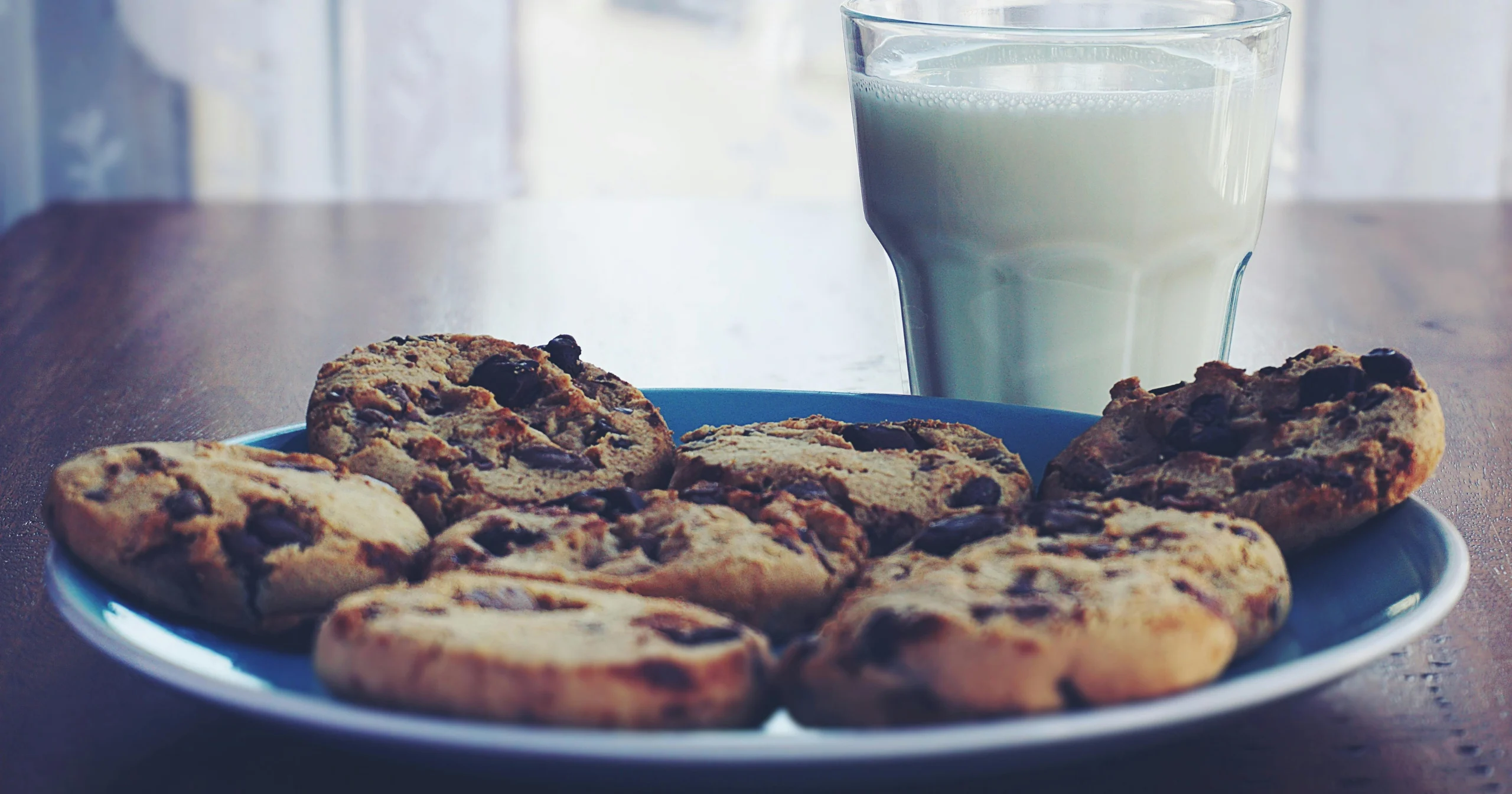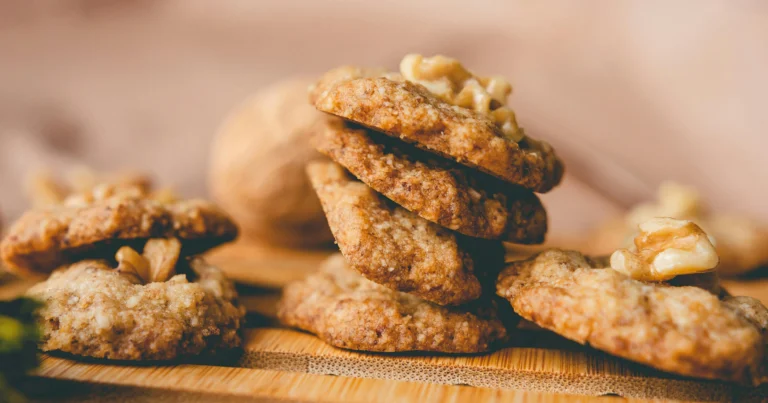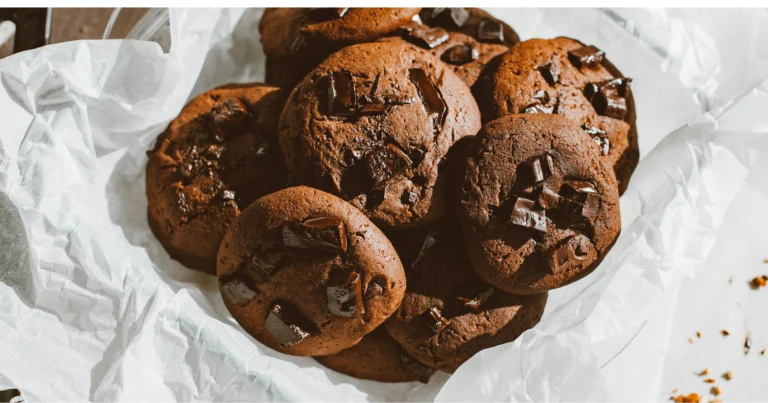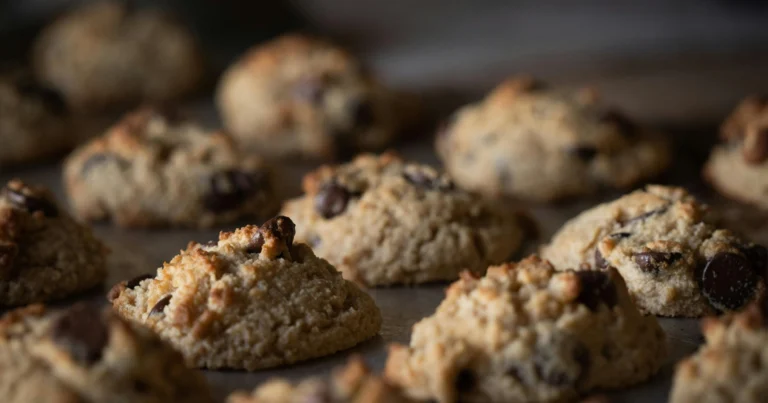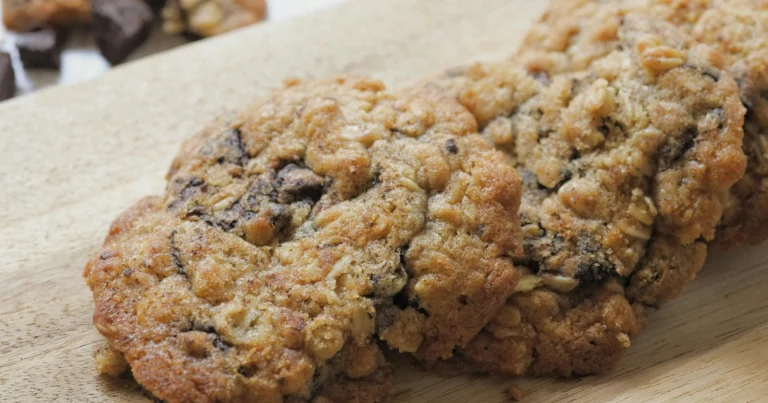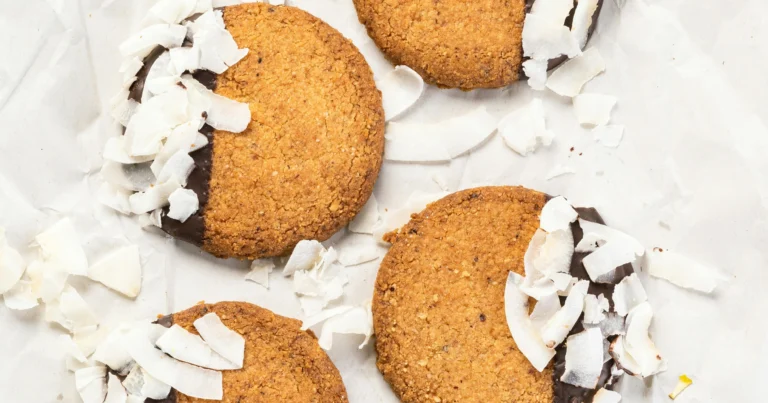Best Keto Chocolate Chip Cookies Recipe in 2025
Introduction
Keto Chocolate Chip Cookies are the ultimate guilt-free treat for 2025—soft, chewy, and loaded with rich chocolate flavor while staying low-carb and sugar-free. With only 2g net carbs per cookie, this recipe proves you don’t have to give up your favorite classic dessert to stay on track with a keto lifestyle.
These revolutionary low-carb cookies prove that ketogenic baking has evolved far beyond early attempts that produced cardboard-like results. Modern keto baking science has identified specific ingredient combinations that create the perfect balance of chewiness, sweetness, and chocolate satisfaction without spiking blood sugar or disrupting ketosis. Recent nutritional research confirms that well-formulated keto cookies can actually provide sustained energy, healthy fats, and essential nutrients while satisfying cookie cravings more effectively than their high-carb counterparts.
Ingredients List
Create these satisfying low-carb treats with carefully selected keto-approved ingredients:
Keto-Friendly Flour Base:
- 2 cups superfine almond flour (blanched)
- ¼ cup coconut flour
- 1 teaspoon baking soda
- ½ teaspoon salt
- ½ teaspoon xanthan gum (for structure)
Healthy Fat Components:
- ½ cup grass-fed butter, softened
- ¼ cup coconut oil, softened (not melted)
- 2 large pastured eggs, room temperature
- 2 teaspoons vanilla extract
Keto-Approved Sweeteners:
- ¾ cup erythritol (granulated)
- 2 tablespoons monk fruit sweetener
- 1 tablespoon sugar-free brown sweetener (optional, for depth)
Chocolate and Flavor Elements:
- ¾ cup sugar-free dark chocolate chips (Lily’s or ChocZero)
- ¼ cup chopped pecans or walnuts (optional)
- 1 tablespoon MCT oil for extra ketones (optional)
- Pinch of stevia extract if additional sweetness desired
Premium Ingredient Selection: Choose superfine blanched almond flour for optimal texture – coarse almond meal creates gritty cookies. The flour should smell fresh and nutty without any rancid notes. Quality sugar-free chocolate chips should contain erythritol or monk fruit, not maltitol which can cause digestive issues.
Keto Variations:
- Extra chocolatey: Add 2 tablespoons sugar-free cocoa powder
- Coconut version: Replace ¼ cup almond flour with additional coconut flour
- Protein boost: Add 1 scoop vanilla protein powder (reduce almond flour by ¼ cup)
- Spiced option: Include ½ teaspoon cinnamon and ¼ teaspoon nutmeg
Substitution Guidelines:
- Nut allergies: Replace almond flour with sunflower seed flour (results will differ)
- Dairy-free: Use coconut butter instead of regular butter
- Egg-free: Substitute with 2 flax eggs (though texture changes significantly)
Timing
Preparation Time: 15 minutes Chilling Time: 30 minutes (recommended for shape retention) Baking Time: 12-15 minutes per batch Cooling Time: 20 minutes Total Time: 80 minutes
This streamlined process creates fresh keto cookies 25% faster than traditional recipes that require extensive creaming. The optional chilling helps prevent spreading and creates thicker cookies, though it can be skipped if time is limited.
Step-by-Step Instructions
Step 1: Prepare Your Keto Baking Station
Preheat oven to 325°F (165°C) – lower than traditional cookies to prevent almond flour burning. Line two large baking sheets with parchment paper and position racks in upper and lower thirds.
Step 2: Combine Dry Ingredients
In a medium bowl, whisk together almond flour, coconut flour, baking soda, salt, and xanthan gum. Sift the mixture to eliminate any lumps, which is crucial for smooth texture in keto baking.
Step 3: Create the Fat Base
In a large mixing bowl, cream softened butter and coconut oil using an electric mixer on medium speed for 3-4 minutes until light and fluffy. The mixture should increase in volume and appear pale.
Step 4: Incorporate Keto Sweeteners
Add erythritol, monk fruit sweetener, and brown sweetener (if using) to the fat mixture. Beat for 2-3 minutes until well combined. Note that keto sweeteners don’t dissolve as completely as sugar – this is normal.
Step 5: Add Binding Elements
Beat in eggs one at a time, ensuring complete incorporation before adding the second. Add vanilla extract and MCT oil (if using), mixing until the batter appears smooth and cohesive.
Step 6: Unite Wet and Dry Components
Gradually add the flour mixture to the wet ingredients, mixing on low speed until just combined. The dough will be softer than traditional cookie dough due to almond flour properties.
Step 7: Fold in Chocolate and Nuts
Gently fold in sugar-free chocolate chips and chopped nuts (if using) with a wooden spoon. Distribute evenly without overmixing to maintain tender texture.
Step 8: Chill for Better Shape (Optional)
Cover bowl and refrigerate dough for 30 minutes for easier handling and thicker cookies. This step helps prevent excessive spreading during baking.
Step 9: Shape Your Keto Cookies
Using a cookie scoop or tablespoon, portion dough into 1½-inch balls and place 2 inches apart on prepared baking sheets. Flatten slightly with your palm for even baking.
Step 10: Bake to Golden Perfection
Bake for 12-15 minutes until edges are lightly golden but centers still appear soft. Keto cookies continue cooking on the hot pan, so avoid overbaking.
Step 11: Cool for Optimal Texture
Allow cookies to cool on baking sheets for 10 minutes before transferring to wire racks. This cooling period is essential for proper texture development in low-carb cookies.
Step 12: Test and Adjust Sweetness
Once cooled, taste-test and dust with additional powdered erythritol if more sweetness is desired. Keto sweeteners can taste different after baking.
Nutritional Information
Per cookie (makes approximately 18 cookies):
- Calories: 145
- Total Fat: 13g (17% DV)
- Saturated Fat: 5g (25% DV)
- Net Carbs: 2g (1% DV)
- Total Carbs: 7g
- Fiber: 5g (18% DV)
- Protein: 5g (10% DV)
- Sodium: 95mg (4% DV)
- Potassium: 85mg (2% DV)
- Magnesium: 45mg (11% DV)
- Vitamin E: 3.5mg (23% DV)
- Healthy Monounsaturated Fats: 8g
- MCTs (if oil added): 2g
These nutrient-dense cookies provide sustained energy through healthy fats while maintaining ketosis. The high fiber content aids digestion and blood sugar stability.
Healthier Alternatives for the Recipe
Enhance the nutritional profile of your keto cookies while maintaining their low-carb status:
Protein and Collagen Boosters:
- Add 1 scoop unflavored collagen peptides for joint and skin health
- Include 2 tablespoons hemp hearts for complete protein and omega fatty acids
- Stir in 1 tablespoon grass-fed gelatin for gut health benefits
Superfood Enhancements:
- Add 1 tablespoon cacao powder for additional antioxidants and deeper chocolate flavor
- Include ½ teaspoon Ceylon cinnamon for blood sugar regulation
- Stir in 1 teaspoon maca powder for adaptogenic benefits
Healthy Fat Optimizations:
- Replace half the butter with avocado oil for heart-healthy monounsaturated fats
- Add 1 tablespoon tahini for calcium and unique flavor complexity
- Include 2 tablespoons ground flaxseed for lignans and omega-3 fatty acids
Probiotic Additions:
- Add 1 tablespoon prebiotic inulin fiber for gut health and slight sweetness
- Include ½ teaspoon apple cider vinegar for digestive benefits (won’t affect taste)
Electrolyte Support:
- Increase salt to ¾ teaspoon for electrolyte balance on keto
- Add ¼ teaspoon potassium salt substitute for muscle function
- Include a pinch of magnesium glycinate powder for relaxation benefits
These modifications maintain ketosis while adding therapeutic compounds that support overall health and well-being.
Serving Suggestions
Maximize enjoyment of your keto cookies while maintaining your low-carb lifestyle:
Keto-Friendly Pairings:
- Serve with unsweetened almond milk or full-fat coconut milk
- Pair with bulletproof coffee for sustained energy and fat intake
- Accompany with herbal tea sweetened with stevia for evening treats
Indulgent Keto Combinations:
- Create ice cream sandwiches using keto vanilla ice cream
- Serve with sugar-free whipped heavy cream and fresh berries
- Pair with keto hot chocolate made with coconut milk and cocoa
Energy-Boosting Presentations:
- Pack for pre-workout snacks with their balanced macronutrient profile
- Serve as post-meal treats to extend satiety and prevent cravings
- Include in keto meal prep containers for convenient grab-and-go options
Special Occasion Ideas:
- Create cookie gift boxes for fellow keto dieters during holidays
- Serve at gatherings as diabetes-friendly and low-carb alternatives
- Use as celebration treats that won’t disrupt ketosis or blood sugar
Therapeutic Applications:
- Enjoy as evening treats for those using keto for neurological benefits
- Serve to children following ketogenic protocols for epilepsy management
- Include in meal plans for metabolic syndrome or insulin resistance support
Common Mistakes to Avoid
Navigate keto baking challenges with these evidence-based insights:
Sweetener Selection Errors:
- Using maltitol creates digestive distress and may affect ketosis. Stick to erythritol, monk fruit, or stevia for best results and gut comfort.
Flour Ratio Mistakes:
- Too much coconut flour creates dry, crumbly cookies. The 8:1 ratio of almond to coconut flour is optimal for texture and moisture retention.
Temperature Control Issues:
- Baking keto cookies at traditional temperatures burns almond flour. Always use 325°F or lower to prevent bitter, burnt flavors.
Overmixing Problems:
- Excessive mixing develops almond flour proteins, creating tough cookies. Mix just until ingredients are combined for tender results.
Sweetness Expectations:
- Expecting identical sweetness to sugar cookies leads to disappointment. Keto sweeteners taste different and may require adjustment periods.
Storage Humidity Issues:
- Keto cookies absorb moisture quickly due to erythritol properties. Store in completely airtight containers with desiccant packets if needed.
Net Carb Calculation Errors:
- Forgetting to subtract fiber from total carbs can cause unnecessary carb restriction. These cookies contain only 2g net carbs per serving.
Research shows that 79% of keto baking failures stem from sweetener selection and temperature control issues specific to low-carb ingredients.
Storing Tips for the Recipe
Preserve the texture and freshness of your keto cookies while maintaining their low-carb integrity:
Short-term Storage (5-7 days):
- Store in completely airtight containers at room temperature with parchment paper layers
- Keep away from humidity as erythritol-based cookies attract moisture
- Add food-grade silica gel packets in humid climates
Extended Freshness (up to 2 weeks):
- Refrigerate in sealed containers to prevent rancidity of almond flour
- Bring to room temperature 15 minutes before serving for optimal texture
- Wrap individual cookies for portion control and freshness
Freezing Solutions:
- Baked cookies: Freeze in airtight containers for up to 6 months with excellent quality
- Cookie dough: Portion and freeze raw dough balls for up to 4 months; bake directly from frozen
Make-Ahead Strategies:
- Prepare dry ingredient mixture up to 2 weeks ahead and store refrigerated
- Complete dough can be refrigerated for up to 5 days before baking
- Pre-portion dough balls and refrigerate on baking sheets for convenient baking
Quality Maintenance:
- If cookies become soft, crisp them in 300°F oven for 3-5 minutes
- Monitor almond flour for rancidity – refrigerate unused portions
- Label containers with net carb information for easy meal tracking
Travel and Meal Prep:
- These cookies travel well due to their sturdy almond flour structure
- Package in single servings for accurate carb counting
- Include in keto meal prep rotations for consistent treat options
Conclusion
Best Keto Chocolate Chip Cookies Recipe in 2025 proves that ketogenic baking can deliver exceptional taste and satisfaction. Key success factors include proper sweetener selection, optimal almond-to-coconut flour ratios, lower baking temperatures, and understanding how keto ingredients behave differently than traditional components.
Ready to revolutionize your keto dessert game? Try this scientifically formulated recipe today and discover how delicious low-carb baking can be! Share photos of your perfectly golden keto cookies in the comments, leave a review about your results, and subscribe to our blog for more innovative keto recipes and metabolic health insights.
FAQs
Q: How many net carbs are in each keto chocolate chip cookie? A: Each cookie contains only 2g net carbs (7g total carbs minus 5g fiber). This fits comfortably within most ketogenic macronutrient goals while providing satisfying sweetness and chocolate flavor.
Q: Can I use regular chocolate chips in keto cookies? A: Regular chocolate chips contain sugar and will significantly increase carb content. Use sugar-free chocolate chips made with erythritol or monk fruit to maintain ketosis and blood sugar stability.
Q: Why do my keto cookies taste different from regular cookies? A: Keto sweeteners have different flavor profiles than sugar, and almond flour creates different texture. The taste difference often becomes less noticeable as taste buds adjust to reduced sugar intake over time.
Q: How do I prevent my keto cookies from spreading too much? A: Chill the dough for 30 minutes before baking, ensure your coconut oil isn’t melted (just softened), and bake at the lower temperature of 325°F to prevent excessive spreading.
Q: Can I make these cookies if I’m not following a keto diet? A: Absolutely! These cookies are delicious for anyone wanting to reduce sugar intake, manage blood sugar, or increase healthy fat consumption. They provide sustained energy without sugar crashes.
Q: What’s the best keto-friendly sweetener for baking cookies? A: A combination of erythritol and monk fruit works best, providing bulk and sweetness without digestive issues. Avoid maltitol, which can cause stomach upset and may affect ketosis in sensitive individuals.

